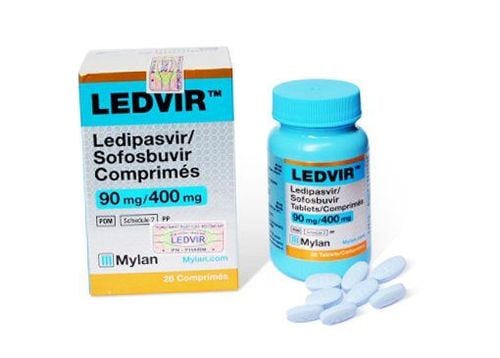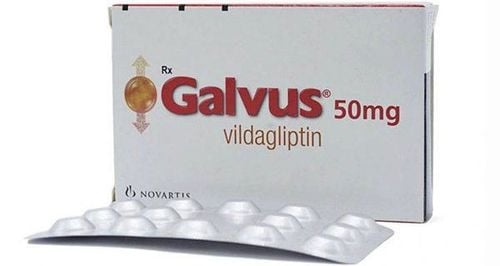This is an automatically translated article.
The drug Sitagil is a medicine for the treatment of diabetes. It may be used alone or in combination with other medications to help control diabetes symptoms.
1. What are the uses of Sitagil 100?
The main ingredient in Sitagil 100 is Sitagliptin 100mg. Sitagliptin is an oral antidiabetic drug belonging to the group of dipeptidyl peptidase-4 (DPP-4) inhibitors. DPP-4 is an enzyme that inactivates dietary insulin-stimulating hormones (also known as incretin hormones), including GLP-1 and GIP.GIP and GLP - 1 stimulate the pancreas to synthesize and release insulin from pancreatic beta cells, depending on glucose levels (when glucose levels are normal or high). GLP-1 also reduces the secretion of the hormone glucagon from pancreatic alpha cells, leading to a decrease in the breakdown of glycogen by the liver into glucose into the blood. Under normal physiological conditions, the hormone incretin is released by the small intestine throughout the day and the concentration increases after eating; These hormones are then quickly inactivated by the DPP-4 enzyme. Therefore, the use of drugs will inhibit the enzymes that inactivate DPP-4.
For patients with type 2 diabetes, sitagliptin inhibits the activity of DPP-4 enzyme for 24 hours, so it has the following effects:
Increases the activity of GLP-1 and GIP in the circulation; Decrease in glucagon levels; Increased insulin response to glucose; Increases peptide C and insulin levels. Thereby, helping to lower blood sugar. In studies in healthy subjects, sitagliptin did not lower blood sugar and did not cause hypoglycemia.
After oral administration, Sitagil drug is rapidly absorbed from the gastrointestinal tract, reaching peak plasma concentrations in about 1 - 4 hours. Food does not affect the absorption and effect of the drug.
2. Indications and contraindications of the drug Sitagil
Sitagil 100 mg is indicated for use in the following cases:
Monotherapy to control type 2 diabetes (non-insulin dependent diabetes) with diet and exercise. In combination with other oral antidiabetic agents for the control of type 2 diabetes, in patients with inadequate glycemic control on monotherapy or for dual antidiabetic regimens. drink. Combination with insulin: When used alone, insulin does not control blood glucose. Sitagil is contraindicated in the following cases:
Hypersensitivity to the active ingredient sitagliptin or any of its ingredients. Type 1 diabetes is also known as insulin dependent diabetes. Diabetics are suffering from ketoacidosis.
3. Dosage and usage of Sitagil 100
3.1. How to take Sitagil When taking Sitagliptin monotherapy, take it once a day, with or without food. In case Sitagliptin is used in a fixed combination regimen of Sitagliptin and Metformin hydrochloride, take the combination twice daily with meals, increasing the dose slowly to minimize the gastrointestinal side effects of Metformin hydrochloride.
3.2 Dosage of Sitagil For people who have not been treated before:
Monotherapy: Adults take a dose of 100mg and use it once a day. Combination therapy with Metformin: Use Sitagliptin 100 mg, once a day. Combination therapy with another antidiabetic agent such as PPAR-y agonists: Use Sitagliptin 100 mg once daily. Combination therapy with Sulphonylurea or with insulin: Use Sitagliptin 100 mg, once a day. The dose of Sulphonylurea or insulin should be reduced to minimize the risk of hypoglycaemia. The fixed combination regimen between Sitagliptin and Metformin hydrochloride:
In humans, blood glucose levels cannot be controlled with Sitagliptin monotherapy: Initiate a fixed combination of 50mg Sitagliptin and 500mg Metformin hydrochloride, taken daily. 2 times. If necessary, increase the dose of Metformin by using a fixed combination of 50mg Sitagliptin and 1g Metformin hydrochloride, orally twice daily. Maximum dose of Sitagliptin 100 mg and 2 g Metformin hydrochloride per day. In patients with uncontrolled blood glucose levels with Metformin monotherapy: Depending on the dose of Metformin being applied, a starting dose of a fixed combination of 50 mg Sitagliptin and 500 mg Metformin or 50 mg Sitagliptin and 1 g may be selected. Metformin, taken twice a day. In special subjects:
Renal impairment In patients with mild renal impairment (creatinine clearance > 50 ml/min), no dose adjustment is required.
For patients with moderate renal impairment (30 < creatinine clearance < 50 ml/min), the recommended dose of sitagil is 50 mg once daily.
For patients with severe renal impairment (ClCr < 30 ml/min) or patients with end-stage renal disease requiring hemodialysis or peritoneal dialysis, the recommended dose of sitagil is 25 mg once daily. The drug can be used without regard to the hemodialysis time.
Hepatic impairment No dose adjustment is required for patients with mild to moderate hepatic impairment. Safety and efficacy in patients with severe hepatic impairment have not been established.
Elderly Care should be taken when choosing a dose because renal function in the elderly may decrease. Dosage depends on the degree of renal filtration.
Children The safety and effectiveness of Sitagil in children under 18 years of age have not been established at this time.
4. Possible side effects when taking Sitagil 100
When using Sitagil 100 mg, you may experience unwanted effects, including:
Common: Hypoglycaemia, headache. Uncommon side effects: Dizziness, dizziness, itching on the skin. Other side effects: Hypersensitivity reactions including anaphylaxis, interstitial pneumonia, vomiting, acute pancreatitis, hemorrhagic necrotizing pancreatitis, angioedema, rash, urticaria, skin vasculitis, Stevens-Johnson syndrome, exfoliative dermatitis, bullous pemphigus, musculoskeletal pain, back pain, joint disease, decreased renal function, acute renal failure. During treatment if serious reactions are observed, especially if acute pancreatitis is suspected, do appropriate laboratory tests such as serum and urine amylase, amylase/creatinine clearance, electrolytes, and calcium. Serum, blood glucose and lipase levels to diagnose the disease, need to stop taking Sitagliptin and provide supportive treatment promptly because this side effect can be fatal.
5. Note when using Sitagil 100
Some things to keep in mind when taking Sitagil include:Acute pancreatitis or pancreatitis with necrotizing hemorrhagic disease has been reported in people using Sitagliptin or taking Sitagliptin in combination with Metformin. When using the drug in people with a history of pancreatitis, caution and close monitoring are required. Monitor for possible manifestations of acute pancreatitis such as nausea, vomiting, loss of appetite, severe abdominal pain that persists. If pancreatitis is suspected, Sitagliptin must be discontinued and hospitalised immediately for treatment. Acute pancreatitis usually occurs within the first 30 days of treatment. Risk factors include: Obesity, increased cholesterol and triglycerides in the blood. When taking the drug, it is necessary to evaluate renal function before and periodically. In some patients, side effects such as acute renal failure have occurred, requiring hemodialysis. Use with caution in patients with all stages of renal failure. During periods of stress due to fever, infection or surgery where blood glucose control may be lost, sitagliptin should be discontinued and insulin administered to control it. Reintroduce sitagliptin therapy when the acute hyperglycaemic stress episode has passed. Pregnancy: There are no adequate data on the use of this hypoglycemic agent in pregnant women. Animal studies have shown reproductive toxicity at high doses. Avoid using the drug during pregnancy. Lactation: Sitagliptin is distributed into milk in laboratory animals, but it is not known whether the drug passes into breast milk. Therefore, the drug should not be used by nursing mothers unless the benefits and risks have been carefully weighed. Drug Interactions: Drug interactions can occur that change the effects of the drug, increase toxicity or the risk of side effects. Some drugs that can cause side effects include:
Increased drug effects and toxicity: Alcohol, anabolic steroids, MAO inhibitors (MAOIs), testosterone may increase the hypoglycemic effect of sitagliptin, risk of hypoglycemia when taking the drug. Sitagliptin increases the plasma concentration of digoxin. Beta-adrenergic receptor blockers may mask the hypoglycaemic signs of antidiabetic agents. Reduced effect: Anti-inflammatory corticosteroids, loop diuretics and thiazides, oral contraceptives may cause an antagonism of the hypoglycaemic effect of antidiabetic agents. Drugs such as Ketoconazole, Itraconazole, Ritonavir, Clarithromycin may alter the effects of sitagliptin in patients with severe renal impairment or end-stage renal failure requiring hemodialysis/peritoneal dialysis, however clinical efficacy has not yet been established. evaluate. In addition, during the treatment you do not arbitrarily adjust the dose or quit the drug. Follow your doctor's instructions exactly. You need to combine a moderate diet and exercise to keep your blood sugar levels under control.
Hopefully, through the above article, you have learned the necessary information about Sitagil 100. If you have any questions about taking the drug, please consult your treating doctor.
Please dial HOTLINE for more information or register for an appointment HERE. Download MyVinmec app to make appointments faster and to manage your bookings easily.













